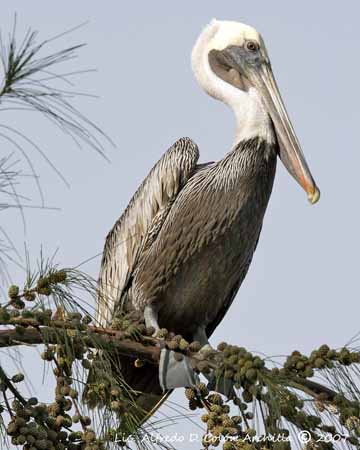
Fr: Pélican brun
All : Braunpelikan
Esp : Alacatraz, Alcatraz, Flamenco, Pélican, Pelícano, Pelícano Alcatraz, Pelícano Café, Pelicano pardo, Pelícano Pardo
Ital : Pellicano bruno
Nd: Bruine Pelikaan
Sd: Brun pelikan
Photographers:
John Anderson
John Anderson Photo Galleries
Didier Buysse
Vision d’Oiseaux
Alfredo Colón
Puerto Rico Wildlife
Tom Grey
Tom Grey's Bird Pictures
Jean-Claude Jamoulle
A la rencontre des Oiseaux
Patrick Ingremeau
TAMANDUA
René Lortie
http://rlortie.ca/
Text by Nicole Bouglouan
Sources:
HANDBOOK OF THE BIRDS OF THE WORLD vol 1 by Josep del Hoyo-Andrew Elliot-Jordi Sargatal - Lynx Edicions - ISBN: 8487334105
A GUIDE TO THE BIRDS OF MEXICO AND NORTHERN CENTRAL AMERICA by Steve N. G. Howell, Sophie Webb - Oxford University Press - ISBN: 0198540124
A GUIDE TO THE BIRDS OF COLOMBIA by Steven L. Hilty and William L. Brown - Princeton University Press – ISBN 069108372X
FIELD GUIDE TO THE BIRDS OF NORTH AMERICA - National Geographic Society - ISBN: 0792274512
BirdLife International (BirdLife International)
Animal Diversity Web (University of Michigan Museum of Zoology)
All About Birds (Cornell Lab of Ornithology)
Bird Web (Seattle Audubon Society)
What Bird-The ultimate Bird Guide (Mitchell Waite)
Brown Pelican
Pelecanus occidentalis
Pelecaniforme Order – Pelecanidae Family
INTRODUCTION:
The Brown Pelican is the darkest of all pelicans. This large bird often appears clumsy when walking on the ground, but it becomes agile and graceful when in flight.
Its fishing behaviour involves strong, short dives from the air into the water, and this is always amazing to see.
This species is gregarious. They may hunt in familiar formations, flying low over the waves. Co-operative fishing sometimes occurs too, but less often than other pelicans.
DESCRIPTION OF THE BIRD:
Biometrics:
Length: 100-137 cm - Bill length: 25-38 cm
Wingspan: 200 cm
Weight: 2000-4000 g
The Brown Pelican has silvery-grey body and upperwing and blackish flight feathers. Underparts are darker. However, the bird may appear dark brown according to the lighting.
The non-breeding adult has white head and neck, including nape and hindneck. The head may be slightly tinged yellow. Bill and gular pouch are grey, like the bare skin of the face.

In breeding plumage, the head is yellow and white, whereas nape and hindneck become dark chestnut-brown. Bill and gular pouch often show some red.
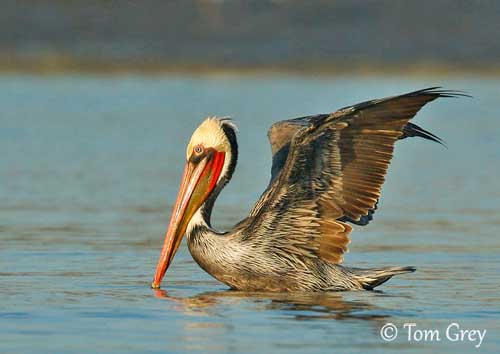
During the nesting period, while the adults are feeding the chicks, the head turns white again, with some scattered dark brown feathers. The hindneck is brown.
This is their usual appearance during the chick-feeding period, following the breeding season.
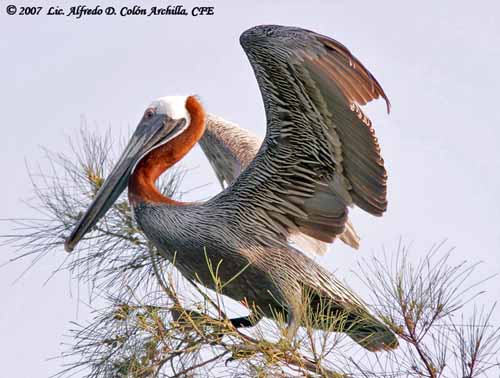
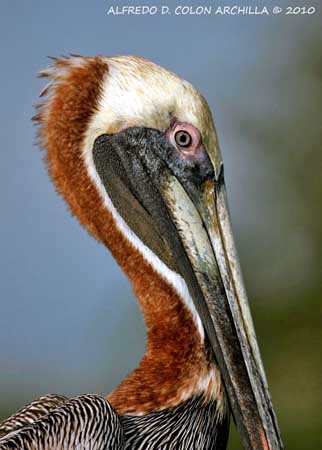
Then, between the nesting period and the next breeding season, the adult has non-breeding plumage with white head, nape and neck, pale reddish bill and brown to orange-yellow gular pouch. This plumage is usual in late autumn.
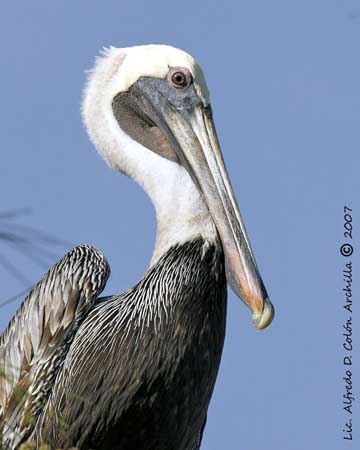
The eyes are straw-white to pale blue, surrounded by bare, broad eyering. The bare skin of the face changes according to the season, from pale blue-grey in non-breeding, to blackish with reddish or pale yellow lores and eyering in breeding plumage.
The large bill (28-35 cm) is greyish with pale reddish tip in non-breeding. It becomes more reddish with red base of gular pouch in breeding season.
The pouch can hold up a large quantity of water, up to 2-3 gallons, much more than the stomach.
Legs and webbed feet are dark grey to black. The webbing can stretch from the front to the hind toe.
Both adults are similar, but the female is slightly smaller than male.

Race "californicus"
California
Race "californicus"
California
Race "occidentalis"
Puerto Rico
Race "occidentalis"
Puerto Rico
Race "occidentalis"
Puerto Rico
Race "occidentalis"
Puerto Rico
The juvenile has brownish to brown neck and upperparts, whereas underparts are mostly white. The eyes are brown. It needs 3-5 years to gains the full adult plumage.

Race "carolinensis"
Key west - Florida
SUBSPECIES AND RANGE:
We can find six subspecies which differ in size, pouch colour and slight plumage differences.
P.o. occidentalis (here described) is found in West Indies.
Race "occidentalis"
Puerto Rico
P.o. carolinensis is found on Atlantic coasts of tropical America, from S Carolina to Orinoco.
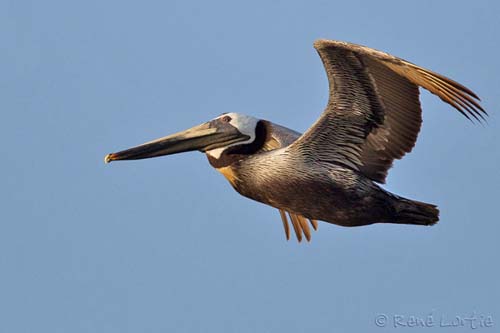
Race "carolinensis"
Louisiana
P.o. californicus occurs on Pacific coasts of N America, from California to Mexico.
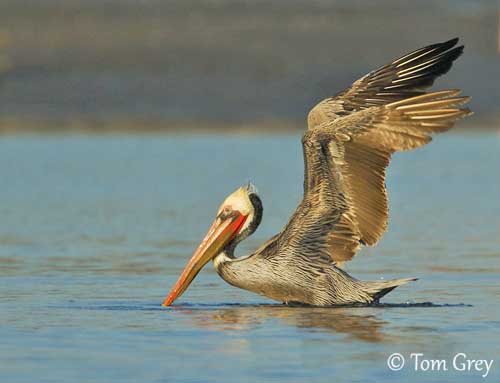
Race "californicus"
California
P.o. murphyi is found in Colombia and N Peru.
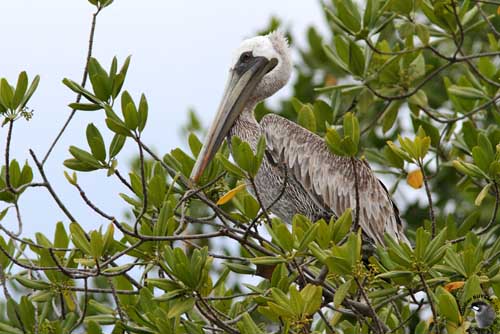
Race "murphyi"
Ecuador
P.o. urinator is found in Galapagos Islands.
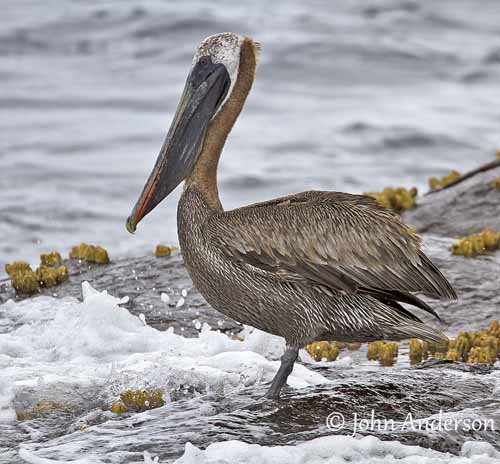
Race "urinator"
Galápagos
P.o. thagus occurs from C Peru to 1/3 N Chile. This race is much larger, with brighter bare parts during breeding season. It is considered today a full species, Pelecanus thagus.
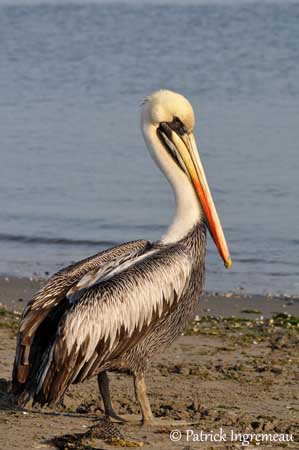
HABITAT:
The Brown Pelican is strictly marine and coastal. It may occasionally follow large rivers during storms. It rarely occurs far offshore. It usually frequents shallow waters along the coasts, and estuaries and bays. It avoids the open sea.
This species breeds on arid coasts on flat, bare, remote islands, occasionally in mangroves. It is often seen around fishing ports.
Race "occidentalis"
Puerto Rico
CALLS ANS SONGS: SOUNDS BY XENO-CANTO
The Brown Pelican has not syringeal muscles and cannot produce vocal sounds. However, it may produce some noises, especially when breeding. The adults produce grunts, rattles, hissing, blowing and some others noises. These sounds are often related to displays or aggression.
The hungry young birds utter groans, yelps, screams, squeaking and grunting.
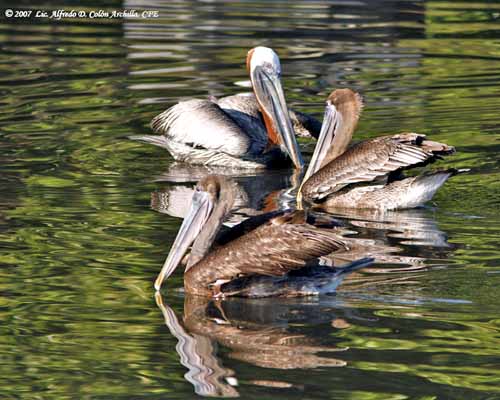
Race "occidentalis"
Puerto Rico
An adult and two young
BEHAVIOUR IN THE WILD:
The Brown Pelican feeds mainly on fish and marine invertebrates. It is the only pelican species which performs plunge-diving for feeding. The prey is detected by sight, while the pelican is flying over the waves. It may dive from up to 10-20 metres height. It also floats on water and feeds by surface-seizing.
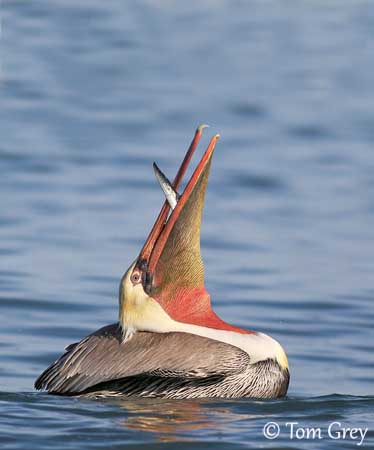
Race "californicus"
California
During the dive, the wings are held in a V, while head and neck are stretched forwards. The speed increases at the moment of impact, by thrusting back wings and feet. The bill is opened in order to catch the prey.
The Brown Pelican usually disappears under water, but thanks to the subcutaneous air-sacs, it quickly appears again, facing the wind in order to take off. Later, the water is drained from the gular pouch before the fish is swallowed.
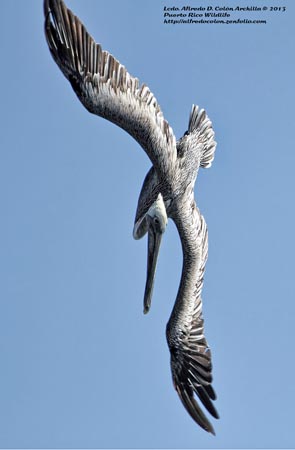
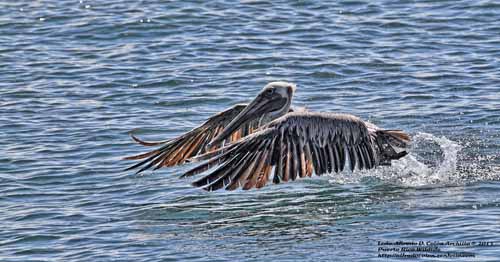
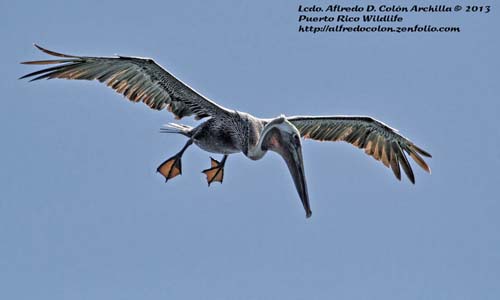
Race "occidentalis"
Puerto Rico
The Brown Pelican usually forages alone, but sometimes, several birds may forage together, driving the fish towards the other birds of the group. But this behaviour is occasional in this species. They forage in the early morning and the evening, and occasionally at night during the full moon. It also scavenges on docks and piers, and around fishing ports.
It is able to drink saltwater, thanks to the salt glands which excrete salt excess. These glands are located on the anterior sides of the eyes.
Race "occidentalis"
Puerrto Rico
The Brown Pelican is seasonally monogamous. The male selects and defends the nest-site prior to courtship and pair formation.
Courtship is initiated by the male, but both sexes participate. Ritual displays include head swaying, bowing and turning, while both partners utter a low “raaa”. These displays last usually 2-4 days, but sometimes up to three weeks before pair-bond occurs.
Several copulations, up to seven, occur before the first egg is laid. The male may perform a post-moulting display, with the bill open while the head is set back on shoulders.
After courtship period, both sexes build the nest, as well in tree or on the ground or cliffs, and breed colonially.
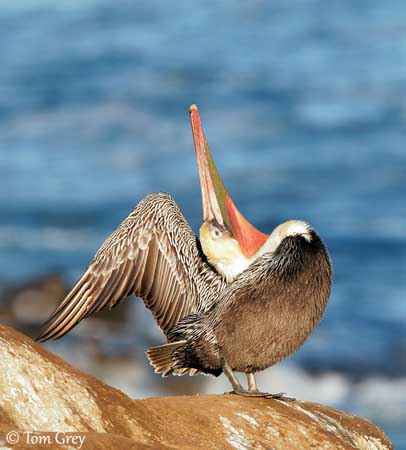
Race "californicus"
California
The Brown Pelican is mainly resident in its range, only performing some dispersion. The northern populations may migrate southwards, but in erratic movements depending on local conditions.
The Brown Pelican is one of the largest and heaviest flying birds. However, the take-off from the water requires a great effort. The bird runs over the surface while beating strongly its wings and pounding the water with the large webbed feet until the speed allows it to become airborne. It often flies low over water or ground, with steady flaps interspersed with glides. Pelicans are powerful and can be graceful fliers.

Race "californicus"
California
REPRODUCTION OF THIS SPECIES:
The breeding season occurs in spring in the northern parts of the range, and all year round in tropics. Peaks vary according to the different sites.
The Brown Pelican breeds colonially, and the sites are sometimes maintained over several years. Other colonies are vulnerable to disturbance or lack of food resources.
The nest is often on the ground and sometimes on cliffs, and only occasionally in bushes or small trees.
On the ground, the nest is a slight depression on the sand, lined with grass, but sometimes, the pair builds a more complex structure with sticks, grass stems and seaweeds. The tree nests are more elaborate stick platform lined with grass and leaves. The male will bring materials to the female during the incubation and the nesting period.
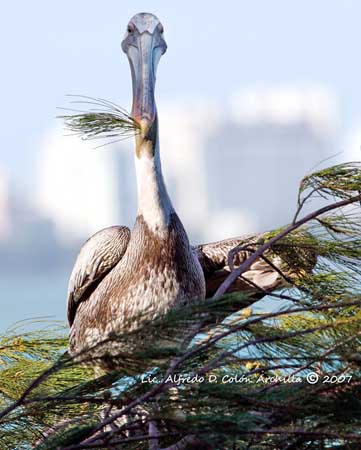
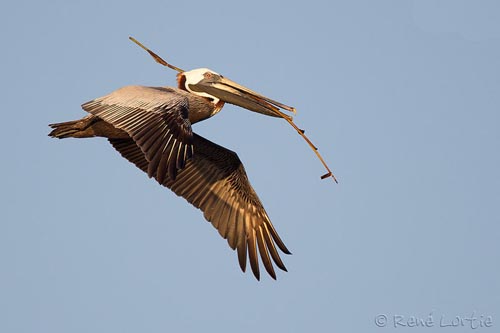
Race "occidentalis"
Puerrto Rico
Race "carolinensis"
Louisiana
The female lays 2-3 chalky white eggs. Both adults share the incubation and all the nesting duties. They incubate the eggs with their webbed feet, turning them from time to time. The incubation lasts 28-30 days. At hatching, the chicks are naked, but about ten days later, some white down appears, and they are completely covered in down at 20 days old.
They are fed by regurgitation of liquid matter, a kind of “fish-soup”, and later, the adults regurgitate fish.
When the nest is on the ground, the young fledge 63 days after hatching, and still depend on parents for two weeks.
The tree-nesters fledge about 74-76 days after hatching and are immediately independent.
The young pelicans are sexually mature at 3-4 years.
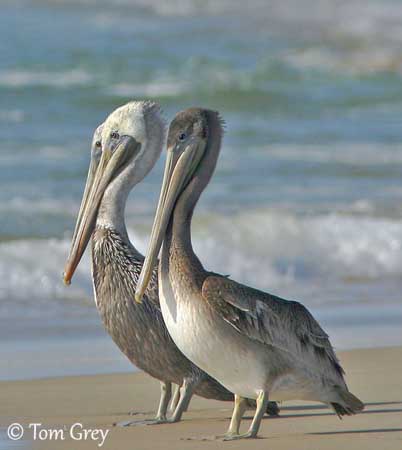

Race "occidentalis"
Puerto Rico
Juvenile
Race "californicus"
California
Two adults and one young
PROTECTION / THREATS / STATUS:
The Brown Pelican is probably the most abundant of all species. It is now threatened by tourists and fishermen disturbances at colonies, especially in Mexico.
However, it is one of the best conservation success stories, and the species has undergone a great recovery after banning of DDT which caused severe decline in the 1960’s and 1970’s.
The Brown Pelican is not currently threatened.
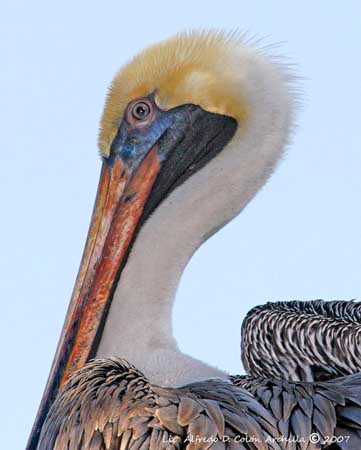
Race "occidentalis"
Puerto Rico
Race "occidentalis"
Puerto Rico
Race "occidentalis"
Puerto Rico
Non-breeding